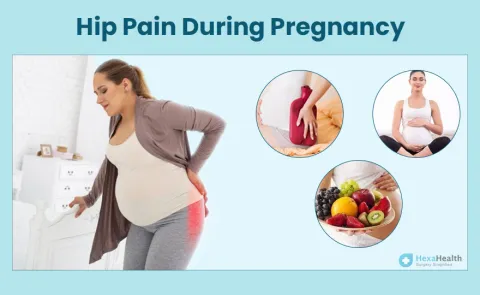Bleeding during Pregnancy - Reason, What to Expect, Solutions

Quick Summary
- Bleeding during pregnancy is quite common, especially during the early stages
- Bleeding and spotting during pregnancy may not lead to something serious, but it is important to find out what's causing it
- Bleeding later in pregnancy is less common and can indicate serious problems, such as placenta previa or placental abruption
Table of Contents
- Difference Between Bleeding and Spotting
- How Much Bleeding is Normal During Early Pregnancy?
- Causes of First Trimester Bleeding
- Causes of Second and Third Trimesters Bleeding
- What Does Bleeding During Pregnancy Look Like?
- How to Diagnose Bleeding Problems During Pregnancy?
- How to Treat Bleeding During Pregnancy?
- When to Call a Doctor?
- Takeaway
- Frequently Asked Questions
- References
Are you pregnant and bleeding? Don’t fret! Bleeding during pregnancy, especially during the early stages, is quite common. About one in four women (25%) experience bleeding or spotting during pregnancy. Many of these women give birth to healthy babies. It is common to have bleeding at some point during the pregnancy, especially during the first trimester. While vaginal bleeding during pregnancy does not always mean a problem, it can indicate a complication or underlying condition.
Bleeding and spotting during pregnancy may not lead to something serious, but your doctor needs to find out what’s causing it. Bleeding later in pregnancy is less common and can indicate serious problems, such as placenta previa or placental abruption. It is always advised to share your symptoms with your healthcare provider, even if bleeding in pregnancy stops.
Since bleeding during pregnancy can sometimes lead to serious complications, it is important to understand what causes it and how it can be managed. Continue reading to find out the causes of bleeding and spotting in different trimesters of pregnancy and the treatment options available to manage the same.
Difference Between Bleeding and Spotting
Bleeding or spotting can happen anytime during pregnancy.
- Vaginal spotting during pregnancy is light bleeding that leaves a few drops of blood in your underwear. It is so light that blood won’t fill a panty liner or pad. Spotting during pregnancy is usually not serious.
- In bleeding, the blood flow is heavier, needing a pad or panty liner to keep the blood from ruining your underwear and clothes.


How Much Bleeding is Normal During Early Pregnancy?
Spotting in early pregnancy, i.e., the first trimester, is usually considered normal and does not indicate a serious issue. Although most causes of first-trimester spotting are not concerning, some might be. Therefore, it is always best to inform your doctor about any spotting or bleeding during pregnancy.
Period-like bleeding is not usually a symptom of pregnancy. Therefore, if you experience anything more than spotting or bleeding that lasts longer than 24 hours, you should call your doctor immediately. Heavy bleeding or bleeding accompanied by pain during pregnancy may indicate a complication.
Causes of First Trimester Bleeding
Spotting or bleeding in early pregnancy or the first trimester is common and usually nothing to worry about. According to a research study, women who experience spotting in the first trimester have pregnancies similar to women who do not bleed. Possible causes of bleeding in the first trimester include:
Implantation Bleeding
Implantation is when the fertilised egg attaches itself to the uterine lining for oxygen and nutrition. It occurs about 6-12 days after conception, causing light spotting or bleeding. Implantation bleeding is considered a normal part of early pregnancy.
Occurring just before the expected period, this type of bleeding is usually mistaken for a light period due to their similar symptoms, such as:
- Mild cramps
- Pain in the lower back
- Tender breasts
- Headache
- Nausea
However, some symptoms may distinguish implantation bleeding from menstrual bleeding. Implantation bleeding is usually light pink or dull brown (a colour lighter than period bleeding). Furthermore, it lasts only a few hours to a couple of days without heavy bleeding.
Molar Pregnancy
- Molar pregnancy is a rare but serious complication in almost 1 in every 1000 pregnant women. It is a condition in which the fertilised egg implants in your uterus, but the foetus may not grow at all.
- Instead, a tumour may form due to a genetic error during fertilisation. A molar pregnancy can lead to a miscarriage in the first trimester. You may experience symptoms such as:
- Bright red or dark brown bleeding
- Pressure or pain in the lower stomach
- Nausea
- Vomiting
Ectopic Pregnancy
Another cause of bleeding during pregnancy is ectopic pregnancy. It is a condition in which the fertilised embryo implants outside of the uterus. Most ectopic pregnancies form in the fallopian tubes (slender tubes that connect the ovaries and the uterus).
If the embryo grows, the fallopian tube can burst, which is life-threatening for the mother. Although this condition is potentially dangerous, it occurs in only about 2% of pregnancies.
Since a baby can grow and develop only in the womb, it is important to treat ectopic pregnancies medically. The symptoms of ectopic pregnancy may include:
- Light or heavy bleeding
- Severe cramps
- Sharp waves of pain
- Rectal pressure
Subchorionic Haematoma
A subchorionic hematoma, or haemorrhage, occurs when blood forms between the uterus wall and the chorionic membrane (the outer layer of the foetal placenta that surrounds and protects the embryo) during pregnancy.
Smaller subchorionic haematomas are common. Women with these haematomas go on to deliver healthy babies. However, large haematomas cause heavy bleeding and increase the risk of miscarriage within the first 20 weeks of gestation. Symptoms of subchorionic haematoma include:
- Light or heavy bleeding
- Pink, red, or brown coloured bleeding
- Pain in the lower stomach
- Cramps
Cervical Polyps
- Cervical polyps are noncancerous, finger-like growths on your cervix. Due to increased oestrogen levels, cervical polyps can get inflamed and irritated, leading to bright red blood during pregnancy. The doctor can easily diagnose these growths during a routine pelvic exam.
Miscarriage
Heavy bleeding in early pregnancy, accompanied by pain, might indicate a miscarriage. Miscarriage usually starts as light bleeding that gets heavier. Most miscarriages cannot be prevented and happen during the first trimester of pregnancy. Symptoms of a miscarriage include:
- Heavy vaginal bleeding
- Bright red to brown coloured bleeding
- Severe cramps
- Pain in the lower abdomen
- Sharp or dull pain in the lower back
- Passing clots of blood or tissue
Sex or a Physical Exam
- Pregnancy hormones make the cervix more tender than normal. Therefore, you may experience light bleeding shortly after sex. Physical tests like a pelvic exam or transvaginal ultrasound can also make your cervix bleed for the same reason.
- However, it is usually not concerning. Bleeding generally happens once and goes away on its own.
Infections
Bleeding in early pregnancy may also be caused by factors unrelated to the pregnancy, such as an infection. An infection in the pelvic area, bladder, or urinary tract can also result in spotting or bleeding during pregnancy.
Infections like chlamydia, gonorrhoea, STIs, UTIs, yeast infection or vaginitis (inflammation) can cause light bleeding. Symptoms of infections include:
- Pink or red spotting or bleeding
- Pain in the lower stomach
- Itching
- White discharge
- Burning during urination
- Sores or bumps on the vagina’s outer part
Causes of Second and Third Trimesters Bleeding
Bleeding later in pregnancy, i.e., in the second and third trimesters, is usually associated with more serious conditions than first-trimester light bleeding. Causes of bleeding in pregnancy during the second and third trimesters include:
- Incompetent cervix: The cervix opens or dilates prematurely, leading to preterm birth.
- Placental abruption: It is a rare, dangerous condition in which the placenta detaches from your uterus wall before or during labour.
- Placenta previa: It is a condition in which the placenta covers a part or all of the cervix. It results in severe bleeding during pregnancy.
- Vasa previa: In this condition, some of the placenta’s blood vessels go across your cervix.
- Preterm labour: Bleeding may occur when you go into labour before 37 weeks of pregnancy. Other symptoms of premature labour include contractions, cramping, or membrane rupturing.
- Problems with the cervix: Infection, inflammation, and growths on the cervix can cause bleeding, which is usually not serious.
- Bloody show: This is a common symptom during late pregnancy in which a small amount of blood and mucus plug is released from the vagina. It may happen a few days before contractions, signalling that the cervix is preparing for labour.
- Uterine rupture: It is a rare but life-threatening condition where the uterus tears open along the scar line from a previous C-section.
- Stillbirth (or intrauterine foetal death): A pregnancy loss after the 20th week of pregnancy can cause bleeding.
What Does Bleeding During Pregnancy Look Like?
Vaginal bleeding during pregnancy does not look the same for everyone. The appearance of the bleeding may vary depending on the cause and the time passed in the pregnancy. Your doctor will want to know how the blood looks to evaluate your symptoms and determine the cause. To determine how urgent your symptoms are, the doctor may need to know the following:
- Colour of the blood: Blood during pregnancy may be pink, brown, or bright red.
- Blood consistency: The blood may be smooth, thick, or watery and contain clots.
- Amount of blood: You may experience a few drops (spotting) or heavy bleeding that fills a pad.
How to Diagnose Bleeding Problems During Pregnancy?
A quick examination can help the doctor understand what is causing bleeding during pregnancy. Your healthcare provider may recommend the following tests:
- Physical exam: The doctor will ask about your symptoms and bleeding. They will perform a vaginal examination to check your uterus’s size and the amount of bleeding.
- Blood test: The doctor will recommend blood tests to check your human chorionic gonadotrophin (hCG), the main hormone in pregnancy. High levels of hCG can indicate a molar pregnancy or twin or multiple pregnancies. Low levels of hCG can indicate abnormal growth, ectopic pregnancy, or a possible miscarriage.
- Ultrasound scan: The doctor may use an ultrasound scan to see where the baby is and how it is growing. The test helps check the baby’s heartbeat, look for signs of an ectopic pregnancy or miscarriage, and the position and health of the placenta.
How to Treat Bleeding During Pregnancy?
The treatment for bleeding in pregnancy depends on the cause of the bleeding. Implantation bleeding does not need treatment as it is a normal process in early pregnancy and has no complications. Some first-trimester issues that cause bleeding, such as a cervical polyp, can be treated in your doctor’s office. Other issues may need further treatments, such as medications or surgery. Treatment options to stop bleeding during pregnancy include:
Home Care
Some treatments for vaginal bleeding during pregnancy that you can perform at home include:
- Resting and relaxing
- Taking some time off work and staying off your feet for a little while
- Avoiding sex
- Avoiding travel
- Avoiding rigorous exercises and heavy lifting
- Using pads rather than tampons when bleeding
- Reporting any changes in your condition to the doctor
Monitoring
- Use a panty liner or sanitary pad to keep track of the amount of bleeding.
Medications
If the bleeding indicates a serious complication in which the pregnancy cannot continue safely, your doctor may prescribe medications. These medications may include:
- Methotrexate (a drug that helps the body absorb harmful tissue and stop cells from dividing in an ectopic pregnancy)
- Misoprostol (a drug used to end a dangerous pregnancy in the first seven weeks)
You will need follow-up appointments to evaluate your health after ending a pregnancy. Your healthcare provider will check for tissue or scarring in the womb.
Surgery
Surgery for ectopic pregnancy is usually reserved for women who do not qualify for medical treatment with Methotrexate.
- The surgery usually involves a laparoscopic procedure to remove ectopic pregnancy from the fallopian tube while saving as much of the tube as possible.
- Furthermore, the treatment for a molar pregnancy also requires a Dilation and Curettage (D&C) surgery. It is a surgical procedure to remove tissue from inside the uterus.
When to Call a Doctor?
You should consult your healthcare professional if you experience bleeding at any stage during pregnancy. Even if bleeding during pregnancy is not serious at the moment, it can cause complications in the future. Call your healthcare professional immediately if you experience any of the following symptoms:
- Heavy bleeding, with or without pain
- Cramps or contractions
- Pain in the pelvic area or abdomen
- Fever of 100.4℉ or higher
- Chills
- Fainting or dizziness
- Vaginal discharge that contains clots or tissue
Takeaway
Bleeding or spotting at any point during pregnancy can be alarming. Mostly, light bleeding and spotting are normal in early pregnancy. However, heavy bleeding during pregnancy may indicate a serious problem. Bleeding in early pregnancy can be caused due to reasons such as implantation, uterine infections, cervical polyps, ectopic pregnancies, miscarriages, etc. Bleeding later in pregnancy can result from conditions such as placental abruption, placenta previa, preterm labour, cervix problems, stillbirth, etc.
You should always consult a doctor if you experience bleeding during pregnancy or have concerns regarding bleeding. Experts at HexaHealth can help resolve all your queries and help you manage the condition. We have a network of the best hospitals and doctors to rule out the possibilities of complications, find the cause of vaginal bleeding during pregnancy, and ensure you and your baby are healthy.
Frequently Asked Questions
Is bleeding during pregnancy common?
Is period-like bleeding during pregnancy normal?
Period-like bleeding is not a symptom of pregnancy. Anything more than spotting or bleeding lasting 24 hours or more is not normal during pregnancy. Call your healthcare provider immediately if you experience heavy bleeding accompanied by pain, as it may indicate a serious problem.
What does vaginal bleeding during pregnancy look like?
Why am I bleeding during pregnancy?
What causes bleeding in early pregnancy?
Can stress cause bleeding in pregnancy?
Yes, stressful life events can increase the chances of vaginal bleeding during pregnancy. When a pregnant woman experiences stress, hormones can fluctuate, and she may experience spotting.
What causes bleeding during the later stages of pregnancy?
How much bleeding is normal in early pregnancy?
How will I know if I am bleeding or spotting?
What are the signs & symptoms of bleeding in early pregnancy at four weeks?
Vaginal spotting or bleeding around the 4th week of pregnancy may happen due to the implantation of the fertilised egg in the uterine lining. Implantation bleeding may be mistaken for period bleeding.
The symptoms of implantation bleeding include mild cramps, pain in the lower back, tender breasts, headache, and nausea. This bleeding is an early sign of pregnancy and usually resolves on its own.
How in pregnancy is bleeding possible?
Why is bleeding normal in early pregnancy?
Bleeding is normal in early pregnancy as it is usually harmless and happens as a part of conceiving. Vaginal bleeding at the start of the pregnancy generally happens due to the implantation of the fertilised egg in your womb’s wall. This bleeding often occurs at the time your menstrual period would have been due.
Is bleeding at three months pregnant normal?
Is vaginal bleeding during pregnancy a sign of miscarriage?
Is bleeding normal in early pregnancy, or is it considered serious?
Does implantation bleeding occur in every pregnancy?
Can I bleed for three days and still be pregnant?
Yes, it is possible to be pregnant and bleeding for three days. This common occurrence in early pregnancy is called implantation bleeding. Implantation happens 6-12 days after conception when the fertilised egg implants into the uterus.
Implantation bleeding is light and lasts only a few hours to a couple of days. However, in some cases, implantation bleeding can go on for upto seven days.
How can we tell whether it is normal or pregnancy bleeding?
Normal period and pregnancy bleeding have similar symptoms, so it is difficult to distinguish between them. Duration and appearance are the two factors that can help know whether it is period or pregnancy blood.
While period blood is bright or dark red and lasts 5-7 days, pregnancy blood is between pink and brown and usually lasts a few hours to about three days.
What are the tests to diagnose vaginal bleeding during early pregnancy?
Your healthcare provider may diagnose vaginal bleeding during pregnancy by evaluating your symptoms.
Some tests that you may have to undergo for bleeding in early pregnancy include blood tests (to check hCG levels), vaginal or pelvic examination (to check the uterus’s size and amount of bleeding), and an ultrasound scan (to check the baby’s position, heartbeat, growth, and health).
Is vaginal spotting during pregnancy a sign of healthy pregnancy?
How is bleeding during late pregnancy confirmed?
To confirm bleeding during late pregnancy, the doctor may perform tests such as ultrasonography (to determine the location of the placenta, umbilical cord, and blood vessels), a complete blood cell count, and tests to determine the blood type and Rh status (to identify a compatible donor if the woman needs a transfusion).
If the mother is Rh-negative, the doctor may perform a blood test to measure how many red blood cells of the foetus are in the mother’s bloodstream.
How is bleeding during pregnancy treated?
What should I eat when bleeding during pregnancy?
No food can help you stop bleeding during pregnancy. However, some foods that you should generally eat to ensure a healthy pregnancy include foods rich in folate and folic acid (cereals, spinach, beans, oranges), calcium (juice, cheese, milk, yoghurt), Vitamin D (fish, eggs), protein (poultry, lentil, peanut butter), and iron (meat, beans, spinach).
How do you stop bleeding naturally?
For minor bleeding in pregnancy, the best natural way to stop bleeding is to get plenty of rest and stay well hydrated. You should see a doctor if the bleeding does not stop or becomes heavier.
What can I do at home to stop my bleeding during pregnancy?
When should bleeding during pregnancy be treated by a doctor?
Can bleeding in pregnancy harm the baby?
What medicine can stop bleeding?
What may happen if bleeding during pregnancy is not treated in time?
Bleeding that continues for over a few hours during pregnancy can indicate a serious problem. If left untreated, it can lead to problems like miscarriage or stillbirth.
If bleeding is caused due to an ectopic pregnancy, the rupture of fallopian tubes can cause internal bleeding, leading to weakness, pain, fainting, shock, or even death.
What are the risks and complications of bleeding in pregnancy?
Last Updated on: 27 February 2023
Reviewer

A specialist in Obstetrics and Gynaecology with a rich experience of over 21 years is currently working in HealthFort Clinic. She has expertise in Hymenoplasty, Vaginoplasty, Vaginal Tightening, Labiaplasty, MTP (Medical Termination...View More
Author

She is an accomplished new-age professional who has interviewed prominent personalities such as Bhaichung Bhutia, G. Sathiyan, Shashi Tharoor, etc. A content writer interested in health communication, graphic desi...View More
Expert Doctors (10)
NABH Accredited Hospitals (5)
Latest Health Articles



























 Open In App
Open In App